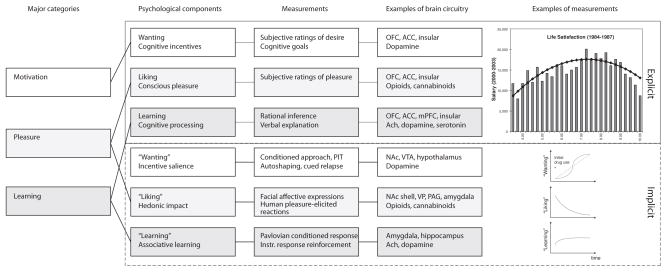Figure 1. Measuring Reward and Hedonia.
Reward and pleasure are multifaceted psychological concepts. Major processes within reward (first column) consist of motivation or wanting (white), learning (light gray), and—most relevant to happiness—pleasure liking or affect (gray). Each of these contains explicit (top three rows) and implicit (bottom three rows) psychological components (second column) that constantly interact and require careful scientific experimentation to tease apart. Explicit processes are consciously experienced (for example, explicit pleasure and happiness, desire, or expectation), whereas implicit psychological processes are potentially unconscious in the sense that they can operate at a level not always directly accessible to conscious experience (implicit incentive salience, habits and “liking” reactions), and must be further translated by other mechanisms into subjective feelings. Measurements or behavioral procedures that are especially sensitive markers of the each of the processes are listed (third column). Examples of some of the brain regions and neurotransmitters are listed (fourth column), as well as specific examples of measurements (fifth column), such as an example of how highest subjective life satisfaction does not lead to the highest salaries (top) (Haisken-De New and Frick 2005). Another example shows the incentive-sensitization model of addiction and how “wanting” to take drugs may grow over time independently of “liking” and “learning” drug pleasure as an individual becomes an addict (bottom) (Robinson and Berridge 1993).

